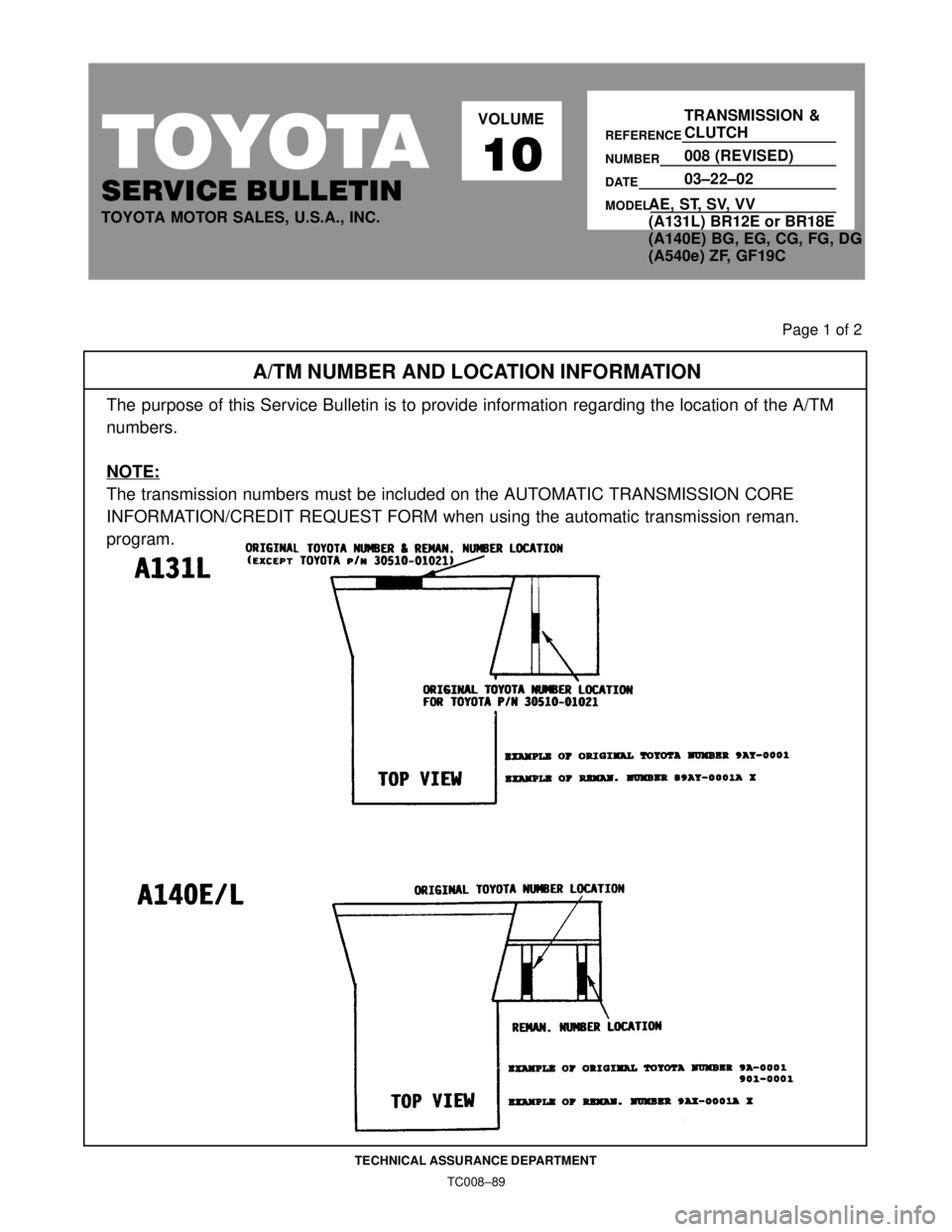1999 TOYOTA CAMRY automatic transmission
[x] Cancel search: automatic transmissionPage 3952 of 4592

Use the following tables to locate and read the original automatic transmission serial number.
Title: AUTOMATIC TRANSMISSION SERIAL NUMBERSPage 1 of 3
DECEMBER 20, 1996
TRANSMISSION &
CLUTCH
TC004-96
ALL MODELS
TRANSMISSION TRANSMISSION
LOCATION
MODEL SERIAL NUMBER
*See Model Code chart on Page 3.96 A E 00001
5-Digit Serial No.
*Model Code
Manufacturing Month:
A thru M (ªIº not used)
Last 2 Digits of
Manufacturing Year:
1996
96 A Y 00001
5-Digit Serial No.
*Model Code
Manufacturing Month:
A thru M (ªIº not used)
Last 2 Digits of
Manufacturing Year:
1996
96 A ZT 00001
5-Digit Serial No.
*Model Code
Manufacturing Month:
A thru M (ªIº not used)
Last 2 Digits of
Manufacturing Year:
1996
A4#D#
A34##
A131L
(AW Product)
A24##
Page 3953 of 4592

AUTOMATIC TRANSMISSION SERIAL NUMBERSPage 2 of 3
* Exception: 1991 ± K, 1992 (January±March) ± M, 1992 (April±December) ± B
NOTE: Remanufactured transmissions also have an additional serial number.
TRANSMISSION TRANSMISSION
LOCATION
MODEL SERIAL NUMBER
6 A 00001
50001
5-Digit Serial No.
Manufacturing Month:
A thru M (ªIº not used)
Last Digit of
Manufacturing Year:
1996
D 01 00001
5-Digit Serial No.
Manufacturing Month:
Manufacturing Year:
A541E:
`93-A, `94-B, `95-C
A540E, A540H:
`90-A, `91-B, `92-C
6 A 00001
5-Digit Serial No.
Manufacturing Month:
A thru M (ªIº not used)
Last Digit of
Manufacturing Year:
1996
A140#
A130L
A131L
(TMC Product)
A132#
A54#E
A540H
A44##
F A 50001
5-Digit Serial No.
Manufacturing Month:
A thru M (ªIº not used)
*Manufacturing Year:
`93-C, `94-D, `95-E
6 01 00001
5-Digit Serial No.
Manufacturing Month:
Last 2 Digits of
Manufacturing Year:
1996
Page 3954 of 4592

AUTOMATIC TRANSMISSION SERIAL NUMBERSPage 3 of 3
MODEL CODE CHART:
CODE MODEL CODE MODEL
A A40 N A45DF, A44D, A45D
w/o Lock-up
B A40D, A40DF P A44DL, A45DF, A45DL
w/Lock-up
C A42D Q A44DE, A45DF, A45DE
ECT, w/Lock-up
D A41 R A340E, A340F
w/lock-up
E A343F S A340H
w/Lock-up
F A43D T A340E
w/o Lock-up
H A43DL U A341H
K A42DL Y A131, A131L
Z A240L, A241L, A242L,
L A43DE, A46DE, A46DF A243L, A2444L, A240E,
A241E, A242E, A244E,
A244F, A241H
M A42DE ZT A245E, A246E
Page 3955 of 4592

TC008±89 TECHNICAL ASSURANCE DEPARTMENT
TOYOTA
SERVICE BULLETIN
TOYOTA MOTOR SALES, U.S.A., INC.VOLUME
10
REFERENCE
NUMBER
DATE
MODEL
TRANSMISSION &
CLUTCH
008 (REVISED)
03±22±02
Page 1 of 2
A/TM NUMBER AND LOCATION INFORMATION
The purpose of this Service Bulletin is to provide information regarding the location of the A/TM
numbers.
NOTE:
The transmission numbers must be included on the AUTOMATIC TRANSMISSION CORE
INFORMATION/CREDIT REQUEST FORM when using the automatic transmission reman.
program.
AE, ST, SV, VV
(A131L) BR12E or BR18E
(A140E) BG, EG, CG, FG, DG
(A540e) ZF, GF19C
Page 4298 of 4592

This system utilizes an engine control module and maintains overall control of the engine, transmission and so on. An outline
of the engine control is explained here.
1. INPUT SIGNALS
(1) Engine coolant temp. signal circuit
The engine coolant temp. sensor detects the engine coolant temp. and has a built±in thermistor with a resistance which
varies according to the water temp. is input into TERMINAL THW of the engine control module as a control signal.
(2) Intake air temp. signal circuit
The intake air temp. sensor is installed in the mass air flow meter and detects the intake air temp., which is input as a
control signal into TERMINAL THA of the engine control module.
(3) Oxygen sensor signal circuit
The oxygen density in the exhaust gases is detected and input as a control signal into TERMINALS OXL1, OXR1
(Except California) and OXS of the engine control module. To maintain stable detection performance by the heated
oxygen sensor, a heater is used for warming the sensor. The heater is also controlled by the engine control module
(HTL, HTR (Except California) and HTS).
(4) RPM signal circuit
Camshaft position and crankshaft position are detected by the camshaft position sensor and crankshaft position sensor.
The camshaft position is input as a control signal to TERMINAL G22+ of the engine control module, and the engine
RPM is input into TERMINAL NE+.
(5) Throttle signal circuit
The throttle position sensor detects the throttle valve opening angle as a control signal, which is input into TERMINAL
VTA1 of the engine control module.
(6) Vehicle speed signal circuit
The vehicle speed sensor, installed inside the transmission, detects the vehicle speed and inputs a control signal into
TERMINAL SPD of the engine control module.
(7) Park/Neutral position SW signal circuit
The Park/Neutral position SW detects whether the shift position is in neutral, parking or not, and inputs a control signal
into TERMINAL STA of the engine control module.
(8) A/C SW signal circuit
The A/C control assembly (Automatic A/C) or A/C Amplifier (Manual A/C) inputs the A/C operations into TERMINAL A/C
of the engine control module as a control signal.
(9) Battery signal circuit
(California or w/ engine immobiliser and/or traction control)
Voltage is always supplies to TERMINAL BATT of the engine control module.
If you turn on the ignition SW, the current goes from TERMINAL MREL of the engine control module to the EFI relay and
put on the relay, and the voltage related to the engine control module operation is supplied to TERMINAL +B of the
engine control module through the EFI relay.
(Except California or w/ engine immobiliser and/or traction control)
Voltage is constantly applied to TERMINAL BATT of the engine control module. When the ignition SW is turned on,
voltage for engine control module start±up power supply is applied to TERMINAL +B of engine control module via EFI
relay.
(10) Intake air volume signal circuit
Intake air volume is detected by the mass air flow meter and a signal is input into TERMINAL VG of the engine control
module as a control signal.
(11) NSW signal circuit
To confirm whether the engine is cranking, the voltage applied to the starter motor during cranking is detected and the
signal is input into TERMINAL NSW of the engine control module as a control signal.
(12) Engine knock signal circuit
Engine knocking is detected by the knock sensor 1 and 2, then the signals are input into TERMINALS KNKR and KNKL
of the engine control module as a control signal.
(13) Air fuel ratio signal circuit (California)
The air fuel ratio is detected and input as a control signal into TERMINALS AFL+, AFR+ of the engine control module.
SYSTEM OUTLINE
Page 4430 of 4592

(1MZ±FE)
Previous automatic transaxle have selected each gear shift using the mechanically controlled throttle hydraulic pressure,
governor hydraulic pressure and lock±up hydraulic pressure. The electronically controlled transmission, however, electrically
controls the line pressure and lock±up pressure etc., through the solenoid valve. Engine control module control of the
solenoid valve based on the input signals from each sensor makes smooth driving possible by shift selection for each gear
which is most appropriate to the driving conditions at that time.
1. GEAR SHIFT OPERATION
During driving, the engine control module selects the shift for each gear which is most appropriate to the driving conditions,
based on input signals from the engine coolant temp. sensor to TERMINAL THW of the engine control module, and also the
input signals to TERMINAL NC2+ of the engine control module from the vehicle speed sensor devoted to the O/D direct
clutch. Current is then output to the electronically controlled transmission solenoid. When shifting to 1st speed, current flows
from TERMINAL S1 of the engine control module to TERMINAL 3 of the electronically controlled transmission solenoid to
GROUND, and continuity to the No.1 solenoid causes the shift.
For the 2nd speed, current flows from TERMINAL S1 of the engine control module to TERMINAL 3 of the electronically
controlled transmission solenoid to GROUND, and from TERMINAL S2 of the engine control module to TERMINAL 6 of the
electronically controlled transmission solenoid to GROUND, and continuity to solenoids No.1 and No.2 causes the shift.
For the 3rd speed, there is no continuity to No.1 solenoid, only to No.2, causing the shift.
Shifting into 4th speed (Overdrive) takes place when there is no continuity to either No.1 or No.2 solenoid.
2. LOCK±UP OPERATION
When the engine control module judges from each signal that lock±up operation conditions have been met, current flows
from TERMINAL SL of the engine control module to TERMINAL 2 of the electronically controlled transmission solenoid to
GROUND, causing continuity to the lock±up solenoid and causing lock±up operation.
3. STOP LIGHT SW CIRCUIT
If the brake pedal is depressed (Stop light SW on) when driving in lock±up condition, a signal is input to TERMINAL STP of
the engine control module, the engine control module operates and continuity to the lock±up solenoid is cut.
4. OVERDRIVE CIRCUIT
*Overdrive on
When the O/D main SW is turned on (O/D off indicator light turns off), a signal is input to TERMINAL OD2 of the engine
control module and engine control module operation causes gear shift when the conditions for overdrive are met.
*Overdrive off
When the O/D main SW is turned to off (O/D off indicator light turns on), the current flowing through the O/D off indicator
light flows through the O/D main SW to GROUND. Causing the indicator light to light up. At the same time, a signal is
input to TERMINAL OD2 of the engine control module and engine control module operation prevents shift into overdrive.
E7 (A), E8 (B), E10 (D), E11 (E) ENGINE CONTROL MODULE (TURN ON THE IGNITION SW)
S1, S2±E1 :9.0±14.0 volts with the solenoid on
0±1.5 volts with the solenoid off
L±E1 :7.5±14.0 volts with the shift lever at L position
2±E1 :7.5±14.0 volts with the shift lever at 2 position
R±E1 :7.5±14.0 volts with the shift lever at R position
STP±E1 :7.5±14.0 volts with the brake pedal depressed
THW±E2 :0.2±1.0 volts with the engine coolant temp. 80°C (176°F)
VAT1±E2 :0.3±0.8 volts with the throttle valve fully closed
3.2±4.9 volts with the throttle valve fully opened
VC±E2 :4.5±5.5 volts
OD2±E1 :9.0±14.0 volts with the O/D main SW turned off
0±3.0 volts with the O/D main SW turned on
+B±E1 :9.0±14.0 volts
OD1±E1 :9.0±14.0 volts
E3 ELECTRONICALLY CONTROLLED TRANSMISSION SOLENOID
2, 3, 6±GROUND : Each 11±15 W
O2 O/D MAIN SW
2±4 : Closed with the O/D main SW off, open with the O/D main SW on
SYSTEM OUTLINE
SERVICE HINTS
Page 4438 of 4592

(5S±FE)
Previous automatic transaxle have selected each gear shift using mechanically controlled throttle hydraulic pressure,
governor hydraulic pressure and lock±up hydraulic pressure. The electronically controlled transmission, however, electrically
controls the line pressure and lock±up pressure etc., through the solenoid valve. Engine control module controls of the
solenoid valve based on the input signals from each sensor which makes smooth driving possible by shift selection for each
gear which is most appropriate to the driving conditions at that time.
1. GEAR SHIFT OPERATION
During driving, the engine control module selects the shift for each gear which is most appropriate to the driving conditions,
based on input signals from the engine coolant temp. sensor to TERMINAL THW of the engine control module, and also the
input signals to TERMINAL SPD of the engine control module from the vehicle speed sensor devoted to the electronically
controlled transmission. Current is then output to the electronically controlled transmission solenoid. When shifting to 1st
speed, current flows from TERMINAL S1 of the engine control module to TERMINAL (B) 3 of the solenoid to GROUND, and
continuity to the No.1 solenoid causes the shift.
For 2nd speed, current flows from TERMINAL S1 of the engine control module to TERMINAL (B) 3 of the solenoid to
GROUND, and from TERMINAL S2 of the engine control module to TERMINAL (B) 1 of the solenoid to GROUND, and
continuity to solenoids No.1 and No.2 causes the shift.
For 3rd speed, there is no continuity to No.1 solenoid, only to No.2, causing the shift.
Shifting into 4th speed (Overdrive) takes place when there is no continuity to either No.1 or No.2 solenoid.
2. LOCK±UP OPERATION
When the engine control module judges from each signal that lock±up operation conditions have been met, current flows
from TERMINAL SL of the engine control module to TERMINAL (A) 1 of the electronically controlled transmission solenoid to
GROUND, causing continuity to the lock±up solenoid and causing lock±up operation.
3. STOP LIGHT SW CIRCUIT
If the brake pedal is depressed (Stop light SW on) when driving in lock±up condition, a signal is input to TERMINAL STP of
the engine control module, the engine control module operates and continuity to the lock±up solenoid is cut.
4. OVERDRIVE CIRCUIT
*O/D main SW on
When the O/D main SW is turned on (O/D off indicator light turns off), a signal is input into TERMINAL OD2 of the engine
control module and engine control module operation causes gear shift when the conditions for overdrive are met.
*O/D main SW off
When the O/D main SW is turned to off, the current through the O/D off indicator light flows through the O/D main SW to
GROUND, causing the indicator light to light up. At the same time, a signal is input into TERMINAL OD2 of the engine
control module and engine control module operation prevents shift into overdrive.
E7 (A), E8 (B), E9 (C) ENGINE CONTROL MODULE (TURN ON THE IGNITION SW)
S1, S2±E1 :9.0±14.0 volts with the solenoid on
0±1.5 volts with the solenoid off
L±E1 :7.5±14.0 volts with the shift lever at L position
2±E1 :7.5±14.0 volts with the shift lever at 2 position
R±E1 :7.5±14.0 volts with the shift lever at R position
STP±E1 :9.0±14.0 volts with the brake pedal depressed
THW±E2 :0.2±1.0 volts with the engine coolant temp. 60°C (140°F) ± 120°C (248°F)
VTA±E2 :0.3±0.8 volts with the throttle valve fully closed
3.2±4.9 volts with the throttle valve fully opened
VC±E2 :4.5±5.5 volts
OD2±E1 :9.0±14.0 volts with the O/D main SW turned on
0±3.0 volts with the O/D main SW turned off
+B±E1 :9.0±14.0 volts
E3 (A), E4 (B) ELECTRONICALLY CONTROLLED TRANSMISSION SOLENOID
(A) 1, (B) 1, (B) 3±GROUND : Each 11±15 W
O2 O/D MAIN SW
2±4 : Closed with the O/D main SW off, open with the O/D main SW on
SYSTEM OUTLINE
SERVICE HINTS
Page 4446 of 4592

7. TAP±UP CONTROL FUNCTION
When the difference between the actual vehicle speed and the set speed is less than 5 km/h (3 mph), the set speed can be
increased 1.6 km/h (1 mph) each time by operation the RESUME/ACCEL SW quickly within 0.6 seconds.
8. TAP±DOWN CONTROL FUNCTION
When the difference between the actual vehicle speed and the set speed is less than 5 km/h (3 mph), the set speed can be
lowered 1.6 km/h (1 mph) each time by operating the SET/COAST SW quickly within 0.6 seconds.
9. AUTO CANCEL FUNCTION
A) If any of the following operating conditions occurs during cruise control operation, the set speed is erased, the current
flow to the magnetic clutch is stopped and the cruise control is released. (Cruise SW turns off).
When this occurs, the ignition SW must be turned off once before the cruise SW will turn on.
*When current continued to flow to the motor inside the actuator in the throttle valve ºOPENº direction.
*The motor does not operate despite the motor drive signal being output.
B) If any of the following operating conditions occurs during cruise control operation, the set speed is erased, the current
flow to the magnetic clutch is stopped and the cruise control is released. (Cruise SW turn off).
When this occurs, the cancel state is cleared as the cruise SW will turn on again.
*Over current to transistor driving the motor and/or the magnetic clutch.
*Open circuit in the magnetic clutch.
*Momentary interruption of vehicle speed signal.
*Short circuit in the cruise control SW.
*When the vehicle speed falls more than 16 km/h (10 mph) below the set speed, E.G. on an upward slope.
C) If any of the following conditions occurs during cruise control operation, the set speed is erased and the cruise control is
released. (The power to the magnetic clutch is cut off until the set SW is ON again.)
*When the vehicle speed falls below the minimum speed limit, approx. 40 km/h (25 mph).
*When power to the cruise control system is momentarily cut off.
D) If any of the following conditions occurs during cruise control operation, the cruise control is released.
*Open the circuit for TERMINAL 2 of the stop light SW.
10. AUTOMATIC TRANSAXLE CONTROL FUNCTION
*In overdrive. If the vehicle speed becomes lower than the overdrive cut speed (Set speed minus approx. 4 km/h, 2.5 mph)
during cruise control operation, such as driving up a hill, the overdrive is released and the power increased to prevent a
reduction in vehicle speed.
*After releasing the overdrive, vehicle speed becomes higher than the overdrive return speed (Set speed minus approx. 2
km/h, 1.2 mph) and the cruise control ECU judges by the signals from the actuator's potentiometer that the upward slope
has finished, the overdrive is resumed after approximately 2 seconds.
*During cruise control driving, the cruise control operation signal is output from the cruise control ECU to the engine control
module. Upon receiving this signal, the engine control module changes the shift pattern to normal.
To maintain smooth cruise control operation (on a downward slope etc.), the lock±up release of the transmission when the
idling point of the throttle position is ON is forbidden.
C3 CRUISE CONTROL ACTUATOR
3±4 : Approx. 38.5 W
C12 CRUISE CONTROL SW [COMB. SW]
5±3 : Continuity with the CRUISE SW on
4±3 : Approx. 418 W with the CANCEL SW on
Approx. 68 W with the RESUME/ACCEL SW on
Approx. 198 W with the SET/COAST SW on
C15 CRUISE CONTROL ECU
9±GROUND :10±14 volts with the ignition SW at ON position
12±GROUND :4 pulses with 1 rotation of rotor shaft
10±GROUND : Approx. 418 W with the CANCEL SW on in the cruise control SW
Approx. 198 W with the SET/COAST SW on in the cruise control SW
Approx. 68 W with the RESUME/ACCEL SW on in the cruise control SW
16±GROUND : Always continuity
SERVICE HINTS